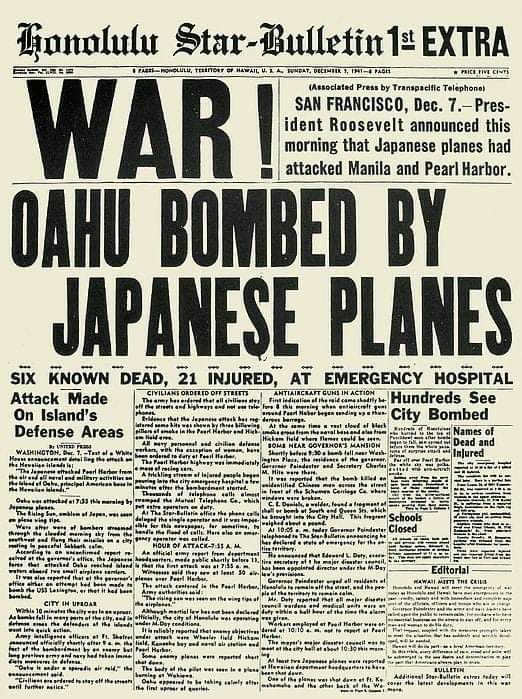D-Day Invasion: Total Recall
D-Day Invasion: Total Recall
No problems of yours are as profound as the problems encountered by those in the second World War. Do look at the level of happiness of this boy on receiving a pair of shoes during the war. This photo could have been staged or could have been taken before or after the war. Arguably, no known history of humankind has so many stories of emotions as happened during the second World War. Therefore, I study the period 1939 - 1945, and aspire to make a feature.
What caused the Second World War?
Briefly, subsequent to the invasion of Poland by Nazi Germany on 1st September 1939, France and Britian declared war. Thus, 81 years ago today on 3rd September, 1939 the Second World War began. What happened next was an unfortunate collateral damage.
If today June 6 had not happened 79 years ago, the world or the history as we know, would have been different, very different. Why, because on 6th June, 1944, D-Day happened. You can learn the significance of the day of paramount importance here:
As an aspiring military historian, today June 6 is of paramount importance, not only for me but for everyone. Because 78 years ago today in 1944, the D-Day invasion happened, the greatest amphibious covert military operation then, which liberated Europe from Nazi invasion. I think it's appropriate I spend the day, recalling memories of the day.
What is D-Day and why is it a significant event in the human history?
D-Day, June 6, 1944 (a day on which a significant operation commences) was the beginning of the operation 'Overlord', an allied forces most audacious amphibious (land, naval, air) military attempt to invade Nazi Europe. Years and months of deception measures favoured allied forces. German forces were always mislead of another location of the assault. But the attack happened on the beaches of Normandy, France. Not only did it cost lives, but painstaking and meticulous planning and execution. Therefore, the D - Day invasion still stands as one of the greatest military covert operations ever.
D-Day was delayed and postponed for several reasons, including weather and strategic. June 6, 1944 wasn't the perfect day for one of the largest military operations ever. Yet, Einsenhower, the supreme commander of allied forces reluctantly gave a go-ahead. The rest is history and in hindsight the decision was correct.
Robert Capa, acclaimed war photographer documented D-Day invasion (Normandy, June 6, 1944), which was the beginning of the victory for the allied forces in world war II. Year later axis forces were defeated. 'If your photographs aren't good enough, you're not close enough.', said #RobertCapa. Auteur Steven Spielberg, said his photographs of D-Day were an inspiration for making the opening sequence of '#SavingPrivateRyan' (Omaha beach, Normandy, France)
Reportedly, a day before D-DAY, on the night of 5th June, 1944, paratroopers of allied forces, dove into Nazi Germany occupied France. Since the resistance from Germans was intense, paratroopers were badly scattered. It took a while for them to regroup and launch counter attack and provide support for the forces infiltrating through Normandy. 'Band Of Brothers', a 10 part series was based on the real, east company, 506th parachute infantry regiment, US 101st airborne division. They were instrumental throughout D-Day and other critical campaigns. Most of them died. Those survived were decorated as war heroes, and the dead were posthumously awarded.
Timestamp of D-Day Invasion:
12:16am. Caen Canal: Six British army gliders land to secure vital bridges.
1.30am. Normandy: The German army raises the invasion alert.
2.40am. France: As British paratroopers drop east of the Orne river, and US "floating headquarters" anchor off Utah and Omaha Beaches, Von Rundstedt decides that the Allied landings are a feint to cover the real invasion force, about to land near Calais.
5.00am.Berchtesgaden: News of the Allied invasion reached Hitler's headquarters, but no one wants to wake him from his drugged sleep.
5.30am.Normandy: The British naval bombardment begins.
6.31am. Normandy: US infantry land on Utah Beach, a mile south of their target. Landings are also under way on Omaha beach.
7.25am. Normandy: British forces land on Sword and Gold beaches.
9.00am. Berchtesgaden: Hitler is woken and immediaty calls a military conference.
12 noon. Klessheim, Germany: Hitler holds an ebullient situation conference.
4.00pm. La Roche Guyon: Rommel arrives back at his headquarters, having driven all the way from Germany since 6am.
4.55pm. Berchtesgaden: Hitler orders the Allied bridgehead "annihilated by the evening of 6 June".
6.50pm. Bletchley Park: British codebreakers discover that the German expect further landings but they have no idea where they will be.
8.55pm. Normandy: Fighting dies down along the entire front.
11.00pm. Hitler holds his second situation conference of the day. He remains convinced that the landings are just a diversionary attack.
Allies preparing for D-Day:
Loading tanks - Sherman tank of the 13th/18th Hussars, 27th Armoured Brigade, reverses aboard an LST at Gosport, 1 June 1944.
Checking tanks - A US officer checks a line-up of newly delivered M4 Sherman tanks at a supply depot in Britain.
Packing parachutes - Members of the Women's Auxiliary Air Force repair and pack parachutes for use by airborne troops during the Normandy invasion.
D-Day was possible because of allied efforts elsewhere.
Image: Russian propoganda poster. 'The Victory is close at hand! More help to the front!'
Assembling landing craft - A large group of LCTs (Landing Craft Tank) moored along the quayside at Southampton.
Attending briefings - Men of 22nd Independent Parachute Company, 6th Airborne Division being briefed for the invasion.
Rehearsing the landings - Troops storm ashore from LCAs during Exercise 'Fabius', a major invasion rehearsal on the British coast.
Constructing artificial bridges - 'Phoenix' concrete caissons, part of the Mulberry artificial harbour, being constructed in Surrey Docks in Rotherhithe, London.
D-Day from air:
Drop Zone 'N' - Aerial photo of part of 6th Airborne Division's Drop Zone 'N' between Ranville and Amfreville, east of the Orne River.
A paratrooper of allied forces getting his gear before boarding C47 on D-Day. They suffered heavy causalities throughout D-Day, and in subsequent campaigns. Most of enemy posts were destroyed by them for land forces to follow.
Allied forces' paratroopers, predominantly US soldiers, diving from C47s into enemy territory, on June 6, 1944 in Nazi occupied North Western Europe, France.
Why did the United States of America enter the Second World War?
Briefly, on December 7, 1941, Japan, which was reportedly agitated by American involvement in trade, assaulted Pearl Harbor. 20 American naval vessels and more than 300 airplanes were destroyed, about 2400 died and 1000 wounded. Consequently, with Adolf Hitler's third Reich declaring war on the United States, America officially entered into the world war II, fighting Germans in the Europe and Japanese in the Pacific.
Some ask me 'Balaji, why are you obsessed about events and films of world war II?
I tell them it is never about politics, doctrines nor war, but real instinctive human emotions, brotherhood and hatred, only existed among soldiers irrespective of nations, during that particular timeline of history. Here is a testimony from a German infantryman, Günter Halm, who served in world war II, which exemplifies my viewpoint.
Brotherhood exists only among soldiers and not civilians:
An American medic is helping an injured German soldier, his enemy, during the second world war. This picture could have been staged. I don't know for certain what exactly happened. But, what I can say for certain with the limited knowledge I acquired on the word war II through reading books, and watching features and documentaries about the period 1939 - 1945, brotherhood only existed among the soldiers of the world war II and continues to exist among soldiers, not the civilians. They are meant to take care of the men next to them in battle. Neither to protect the nation nor to kill an enemy. This trait of the soldiers is what inculcated the aspiration of becoming a military historian in me, especially the second world War.
Below are some films based on D-Day, which have profoundly impacted my conscience:
Why am I obsessed about auteur Steven Spielberg's 'SavingPrivateRyan' (1998)?
While the reasons are several, I can't make them explicit as they could be appreciated only by those who can be connected to the profound section of my mind. However, part of the reasons are: Even though, the storyline of 'Saving Private Ryan' is fictional, the opening sequence of #DDay landings at Omaha beach (Normandy, France) is closest to the actual brutality happened there on 6th June, 1944. Anyone who is sane and has the fighting spirit, can't remain regular after witnessing the bravery and sacrifices of soldiers. I'm frequently reminded by my intuition that in one of my previous incarnations, I was one among them, an allied soldier fought and died for the men next to me, and not the nations, between 1939 and 1945.Therefore, I've chosen to devote my existence for the brothers and this film.
More importantly, the nostalgic reason of watching 'Saving Private Ryan' at Madurai 'Mappillai Vinayagar' (Sri Mappillai Vinayagar)theatre with my father and brother
Operation '#MarketGarden' was the second most important, next to 'D - Day' carried out by the allies to liberate Europe from the invasion of Nazi Germany and end the second world war by Christmas of 1944. Even though, the operation was mostly a success, it resulted in heavy casualties for allies and prolonged war. This film 'A Bridge Too Far' deals with this operation. An essential watch.
#ABridgeTooFar (1977) official trailer and synopsis:
An all-star cast recreates the 1944 Allied defeat at Arnhem in Richard Attenborough's colossal WWII epic. Splendid special effects and mega setpieces illustrate the story of the failure of Operation Market Garden, the Allied attempt to break through German lines and seize several bridges in the occupied Netherlands - including the crucial crossing at Arnhem - with the main objective of outflanking German defences.
https://youtu.be/AWL184ZcSxA
Psychologica Effects of the Second World War:
I don't have the nerve to share this picture. If you have witnessed death, could be natural or artificial, you may empathize it. Even though, I study the second world war, and aspire to become a historian, I'm devastated on seeing this picture and the story behind it. Some may say, this picture was staged. I'm not certain. It appears to be authentic. And, I'm broken. I'm only sharing the Instagram link to this picture. I'm not posting this picture as I'm not able to.
https://www.instagram.com/p/BmSy3CpHut3/?utm_source=ig_share_sheet&igshid=psuyepd9skci
I've always wondered, why there wasn't any insurgency in Nazi Germany and Imperial Japan after their defeat in the world war II? I learnt that not only their economies and war machines completely collapsed, but there was almost no top hierarchy left to lead the resistance. Allies wiped out Axis.
Authored by Balaji Thangapandian aka #BT - a spacefarer, who is also curious about film-making, connectivity technologies and military history.
mindofbt.blogspot.com
tbalajiocha@gmail.com
https://www.facebook.com/balaji.thangapandian
https://www.facebook.com/FilmTheorist/
7 June 1944
U.S. paratroopers (front row) of 'Easy Company' 2nd Battalion of the 506th Parachute Infantry Regiment of the 101st Airborne Division with soldiers from the Army’s 4th Infantry Division that came from Utah Beach, France, Sainte-Marie-du-Mont.
From the right: Forrest Guth, Frank Mellet, David Morris, Daniel West, Floyd Talbert, and C.T. Smith.
Source:
Photograph taken by Walter Gordon.
Colour: https://www.facebook.com/JJcolorization/


































Comments
Post a Comment